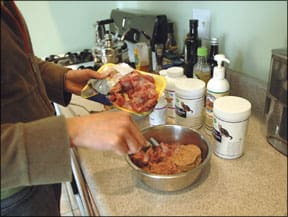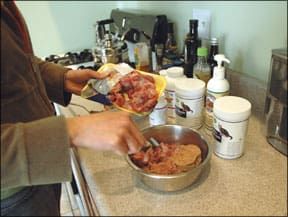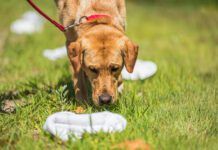Interest in homemade diets has never been greater, especially since the huge pet food recall of 2007. Last month, I reviewed books that explained how to feed a homemade canine diet based on raw meaty bones (RMBs). This month, I’ll look at books about boneless diets – by far the largest category of books.

288
Unfortunately, I found a lot of bad books out there. Many of the recipes provided in the books are nutritionally inadequate! There’s no harm in using them from time to time, or to replace a small portion (up to 25 percent) of a commercial food diet, but anyone who relies on these books to feed their dogs a homemade diet is likely to end up with issues that could range from dry skin to crippling orthopedic conditions.
Calcium, in particular, is often mentioned only in passing or left out of recipes entirely. As just one example of the problems this can cause, I heard from one person who relied on four popular homemade diet books, none of which stressed the importance of added calcium, to create a diet for her puppy. As a result, her pup developed nutritional secondary hyperparathyroidism, a metabolic disorder caused by lack of calcium that can lead to bone deformities and spontaneous fractures. At one point, her puppy’s bones were so soft that when an X-ray was being taken, the technicians actually bent the leg bone. I’m happy to say that the pup appears to have made a full recovery once she began adding calcium to his diet, but this could have resulted in irreparable damage.
In contrast with the RMB books, the books reviewed here provide recipes rather than just diet guidelines. Most of the food is cooked; only two books suggest using raw meat (and only one requires it). Some recipes are simple, consisting of a few, basic ingredients, while others are indistinguishable from human recipes, with multiple ingredients, seasonings, and preparation steps. All diets include grains, though the percentages of meat, grains, and vegetables varies considerably.
Whichever one you choose, please read the whole book, not just the recipes. All of the books I recommend contain essential information in the text about substitutions, supplements, and more. Using the recipes without reading the rest could lead to critical errors in the overall diet.
Unless a book says specifically that the recipes are approved for puppies or for all life stages, assume that they are meant for adult dogs only. Puppies and pregnant or nursing females have special nutritional requirements; if you want to feed them a homemade diet, you must make sure it will meet their needs.
Except where noted, all of the books listed below are available from Amazon.com and other bookstores. Many are also available from Dogwise (dogwise.com; 800-776-2665).
These reviews are directed at homemade diets only. Many of the books contain additional chapters on such topics as herbs, homeopathy, grooming, and more. My recommendation of a book’s diet does not mean that I endorse anything else that the book may say.
I’m saving the best for last: three books that have analyzed all recipes to ensure that they meet the latest NRC guidelines. Each of these books offers recipes for diets with and without raw meaty bones, so whichever type of diet you want to feed is covered. Two of the books focus on raw, grain-free diets approved for all life stages (cooking is permitted), while the third offers cooked and raw recipes, with and without grains, designed for adult dogs only. This review will be published in an upcoming issue.
Home-prepared pioneer
Dr. Pitcairn was an early advocate for homemade diets for dogs, publishing the first edition of Dr. Pitcairn’s Complete Guide to Natural Health for Dogs & Cats way back in 1981.
The latest edition (2005) offers several improvements. The recipes have been revamped; most are moderately higher in both protein and fat and lower in carbs than before. For example, the Doggie Oats recipe increased the amount of meat from two to three pounds and decreased the amount of oats from eight to five cups. The amount of bone meal to add to each recipe has been clarified, as different products vary in how much calcium they contain.
A wide variety of foods are recom-mended, including various meats, liver, eggs, dairy products, grains, legumes, vegetables, and fruit, along with garlic, yeast, and flavorings as soy sauce. Some ingredients, such as liver and fish oil, are discussed in the text but are not included in the recipes. Supplements include vegetable oil; bone meal; vitamins A, D, and E; and Healthy Powder (a mixture of yeast, lecithin, kelp, vitamin C, and bone meal).
Pitcairn stresses the need for variety and suggests substitutions for meats and grains in his recipes. Four of the recipes are vegetarian, but they use eggs and dairy products for protein, which is acceptable. While his recipes are higher in carbs than I prefer, with 36 to 61 percent in the regular meals, they have an adequate amount of protein, ranging from 23 to 33 percent. According to Pitcairn, “You may also feed any of the basic cat recipes to dogs,” a good choice if you want to feed meals that are higher in protein and lower in carbs. Special recipes are provided for dogs with kidney disease, allergies, and weight loss; the latter are high in carbohydrates (not ideal).
Despite the high carbs, this is still one of the better homemade diet books around. You can rely on these recipes to provide complete nutrition for your dog.
Another updated classic
The 2000 edition of Holistic Guide for a Healthy Dog has been completely reorganized, but the diet presented in the book is virtually identical to the original version. A single recipe is provided, split into two meals: a cereal meal that makes up 25 percent and a meat meal that makes up 75 percent of the diet. Cottage cheese is substituted for meat one day a week, and there is a half-day fast (modified cereal meal only) one day each week. The diet is 35 percent protein, 17 to 20 percent fat, and 34 to 39 percent carbs on a dry matter basis.
Much information is unclear in this book, including the amount of bone meal to use, which appears to be too high. The problem is that bone meal can vary greatly in how much calcium it contains. I finally found the brand of bone meal used buried in Appendix 2. I looked it up online and discovered this particular brand has just 720 mg calcium per teaspoon, half the amount found in many products. With no guidance in the text, however, I’m sure many people would get this wrong.
Volhard recommends feeding only beef meat, as she says “testing thousands of dogs through kinesiology for over 20 years has shown me that the majority of dogs prefer beef.” Variations are provided only for dogs who cannot tolerate or will not eat the regular meals. There’s simply no reason to avoid variety, and many reasons not to.
There are other errors and ambiguities in the text, such as the statement that corn oil “contains only a tiny amount of linoleic acid.” You are advised to use blood tests to monitor the diet, but blood tests will not show nutritional deficiencies or excesses unless they are extreme (and often not even then). Many people have had success with this diet, but some dogs don’t like the cereal portion, and the supplements are complicated.
A tad complicated
Better Food for Dogs is one of the better books that use human-style recipes, though that says more about the quality of the competition than about this book itself. Recipes average 40 percent protein, 45 percent carbohydrates, and 15 percent fat on a dry matter basis, which is acceptable.
Variety is stressed, with variations for some recipes provided, but I have a number of reservations about the recipes. Neither liver nor heart is included. Canola oil is added but no omega-3 fatty acids. Some recipes are overly complex.
I like the fact that tables are provided showing the average nutritional analysis for each set of recipes compared to NRC minimum requirements. However, they expect you to use these tables to calculate the amount of bone meal and other vitamin and mineral supplements to add.
As with many books co-authored by veterinarians, you are frequently urged to consult with a professional. I find many of these recommendations unnecessary or impractical, such as, “Giving your dog omega-3 fatty acid supplements should only be undertaken with the guidance of your veterinarian.” and “When purchasing [a daily multivitamin-and-mineral supplement intended for humans], use the charts in Chapter 7 and consult with your pharmacist to ensure that you are adding the proper supplementation without reaching toxic levels.”
All in all, I think this is a better book than those whose diets are higher in carbs and omit calcium, but the recipes and supplements may be more complicated than some people want to deal with.
Eat with a friend
I first read Carol Boyle’s book, Natural Food Recipes for Healthy Dogs, in 2007, when she participated in the sample cooked diets portion of my series of homemade diet articles (“Reality Cooks,” WDJ July 2007). I liked Boyle’s approach to sharing your own meals with your dogs so much that I began incorporating some of her ideas into the diet I feed my own dogs.
Rereading the book now, I’m still impressed. Boyle has a practical, common sense style that makes home feeding seem simple. She calls it “the scatter-shot theory” of good nutrition, using variety, moderation, and balance over time to ensure that her dogs’ nutritional needs are met. She recommends feeding a diet that is two parts protein to one part carbohydrates by volume, with added servings of sweet potato, dairy, and eggs. She recommends feeding two to three meals a month of liver, and the same for canned fish.
It’s important to read Boyle’s text and not just look at the recipes, which are for individual foods rather than for meals. Boyle gives guidelines as to how to combine these foods into meals to create a complete diet. She also stresses the need to add calcium at the rate of 1,000 mg per pound of meat, and gives instructions on using ground eggshells to supply calcium. Note that some recipes include onions, which Boyle advises be removed before serving to dogs.
Boyle suggests feeding a percentage of your dog’s body weight daily. She provides little guidance on supplements, advising that you add vitamins C and E, fish oil, and possibly a multi-vitamin and mineral supplement.
Boyle’s book is a good choice for those who enjoy cooking. You may find it even helps you improve your own nutrition!
Fifty recipes
My name is on the cover (as a contributor) of The Healthy Dog Cookbook. Isn’t there just the tiniest conflict of interest having me review my own book? Fair point – except it’s not really “my” book.
In 2007, I heard from an editor in England who had been contracted by TFH Publications to produce a homemade diet book for dogs. The editor asked if I would be willing to provide recipes for the book. I declined, as I prefer to give diet guidelines rather than recipes. The editor asked if I would write the introduction, and I agreed, provided that the recipes met my criteria: at least half animal products (meat, eggs, fish, dairy); organ meat (particularly liver) included in small amounts; no vegan recipes; and an appropriate amount of added calcium. To my surprise, they agreed.
In the end, I wrote not only the introduction, but also the information presented with each recipe, which included portion sizes (which I now feel are too high) and the amount of calcium to add. My introduction includes sections on the need to provide calcium, variety, and balance over time; protein, fat, and carbohydrates in the diet; food preparation; amount to feed; and supplements. I was paid a fee for my contributions; I do not receive royalties from its sale. I was not aware that they called me a “canine nutritionist” until after the book was published or I would have asked them to change it.
The recipes in this book use what I consider to be appropriate proportions, include a variety of foods, and aren’t complicated to make. Ingredients include various types of meat and fish, liver, heart, eggs, yogurt, cottage cheese, cheese, pasta, oatmeal, barley, quinoa, brown rice, potatoes, sweet potatoes, yams, pumpkin, spinach, carrots, green beans, peas, asparagus, beets, tomatoes, peanuts, and fruit, plus herbs (parsley, dill, mint, thyme).
While this is not the book I would create myself, I think it’s better than many of the recipe books available, particularly those that do not include calcium.
Do as she does, not says
I found myself intrigued by the diet that Joan Weiskopf, author of Pet Food Nation, feeds her own dogs. In her introduction, she describes breakfast five days a week of chicken liver, heart, and gizzards, sautéed in coconut oil. She adds string beans, zucchini, yogurt, and a fish oil gelcap, plus grains in winter. Two mornings a week, she feeds eggs for breakfast. Lunch consists of a raw chicken neck. Dinner is meat, including fish two days a week, plus seasonal vegetables, and sometimes rice or grains as well. So far, so good.
Unfortunately, it was downhill from there. Weiskopf’s book is disorganized, with similar but not always consistent information scattered among different chapters. Weiskopf recommends a diet that is 65 percent protein and 35 percent grains, vegetables, and fruits. Recipes are designed for dogs weighing 20 pounds; she gives no other guidance on portion sizes. While she recommends variety, she does not offer any substitutions in her recipes.
Calcium guidelines are jumbled, and only five of the nine breakfast and dinner recipes include calcium. Note that chicken necks are listed as “Dog Snack/Lunch” that she indulges her dogs in only if they are “particularly active (and insistent).” Supplement recommendations are similarly unclear. She includes “⅛ tsp. probiotic liquid” and “1 fish oil capsule” in her Monday-Friday breakfast recipe and “multivitamin/mineral for dogs” in three of her dinner recipes.
Recipes for dogs with kidney disease are overly restricted in protein. All of the recipes for dogs with health issues are high in fat.
Joan Weiskopf is listed as “MS, Veterinary Clinical Nutritionist,” but she is not a veterinarian. While this book is better than some, due to using appropriate ratios of protein and carbohydrates and including proper amounts of calcium, it is disorganized, sometimes contradictory, does not stress variety, and gives very little guidance regarding supplements. This diet won’t harm your dog, but you can do better.
Could have been simpler
All of the information in Simple Cooking for Dogs 101 is acceptable, but even more details would have been helpful. Human-style recipes are designed to last a few days to a week. All recipes state how many cups they make, and a table gives portion sizes for dogs in eight weight categories. Calcium is not included in the recipes, but is described in the text with appropriate guidelines. Recommended supplements include Missing Link, garlic, canned pumpkin, fish oil, ground flaxseed meal, yogurt, probiotics, digestive enzymes, and various herbs. Guidance may not be specific enough for a beginner.
Mary Straus does research on canine health and nutrition topics as an avocation. She is the owner of the DogAware.com website. She lives with her Norwich Terrier, Ella, in the San Francisco Bay Area.





